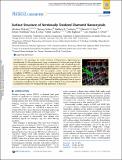| dc.contributor.author | Wolcott, Abraham | |
| dc.contributor.author | Schiros, Theanne | |
| dc.contributor.author | Trusheim, Matthew E | |
| dc.contributor.author | Chen, Edward H | |
| dc.contributor.author | Nordlund, Dennis | |
| dc.contributor.author | Diaz, Rosa E | |
| dc.contributor.author | Gaathon, Ophir | |
| dc.contributor.author | Englund, Dirk | |
| dc.contributor.author | Owen, Jonathan S | |
| dc.date.accessioned | 2021-10-27T20:04:06Z | |
| dc.date.available | 2021-10-27T20:04:06Z | |
| dc.date.issued | 2014 | |
| dc.identifier.uri | https://hdl.handle.net/1721.1/134236 | |
| dc.description.abstract | © 2014 American Chemical Society. We investigate the aerobic oxidation of high-pressure, high-temperature nanodiamonds (5-50 nm dimensions) using a combination of carbon and oxygen K-edge X-ray absorption, wavelength-dependent X-ray photoelectron, and vibrational spectroscopies. Oxidation at 575°C for 2 h eliminates graphitic carbon contamination (>98%) and produces nanocrystals with hydroxyl functionalized surfaces as well as a minor component (<5%) of carboxylic anhydrides. The low graphitic carbon content and the high crystallinity of HPHT are evident from Raman spectra acquired using visible wavelength excitation (λexcit = 633 nm) as well as carbon K-edge X-ray absorption spectra where the signature of a core-hole exciton is observed. Both spectroscopic features are similar to those of chemical vapor deposited (CVD) diamond but differ significantly from the spectra of detonation nanodiamond. The importance of these findings to the functionalization of nanodiamond surfaces for biological labeling applications is discussed. (Figure Presented). | |
| dc.language.iso | en | |
| dc.publisher | American Chemical Society (ACS) | |
| dc.relation.isversionof | 10.1021/JP506992C | |
| dc.rights | Article is made available in accordance with the publisher's policy and may be subject to US copyright law. Please refer to the publisher's site for terms of use. | |
| dc.source | ACS | |
| dc.title | Surface Structure of Aerobically Oxidized Diamond Nanocrystals | |
| dc.type | Article | |
| dc.identifier.citation | Wolcott, A., et al. "Surface Structure of Aerobically Oxidized Diamond Nanocrystals." J Phys Chem C Nanomater Interfaces 118 46 (2014): 26695-702. | |
| dc.contributor.department | Massachusetts Institute of Technology. Department of Electrical Engineering and Computer Science | |
| dc.relation.journal | Journal of Physical Chemistry C | |
| dc.eprint.version | Final published version | |
| dc.type.uri | http://purl.org/eprint/type/JournalArticle | |
| eprint.status | http://purl.org/eprint/status/PeerReviewed | |
| dc.date.updated | 2019-06-14T13:43:10Z | |
| dspace.orderedauthors | Wolcott, A; Schiros, T; Trusheim, ME; Chen, EH; Nordlund, D; Diaz, RE; Gaathon, O; Englund, D; Owen, JS | |
| dspace.date.submission | 2019-06-14T13:43:12Z | |
| mit.journal.volume | 118 | |
| mit.journal.issue | 46 | |
| mit.metadata.status | Authority Work and Publication Information Needed | |
